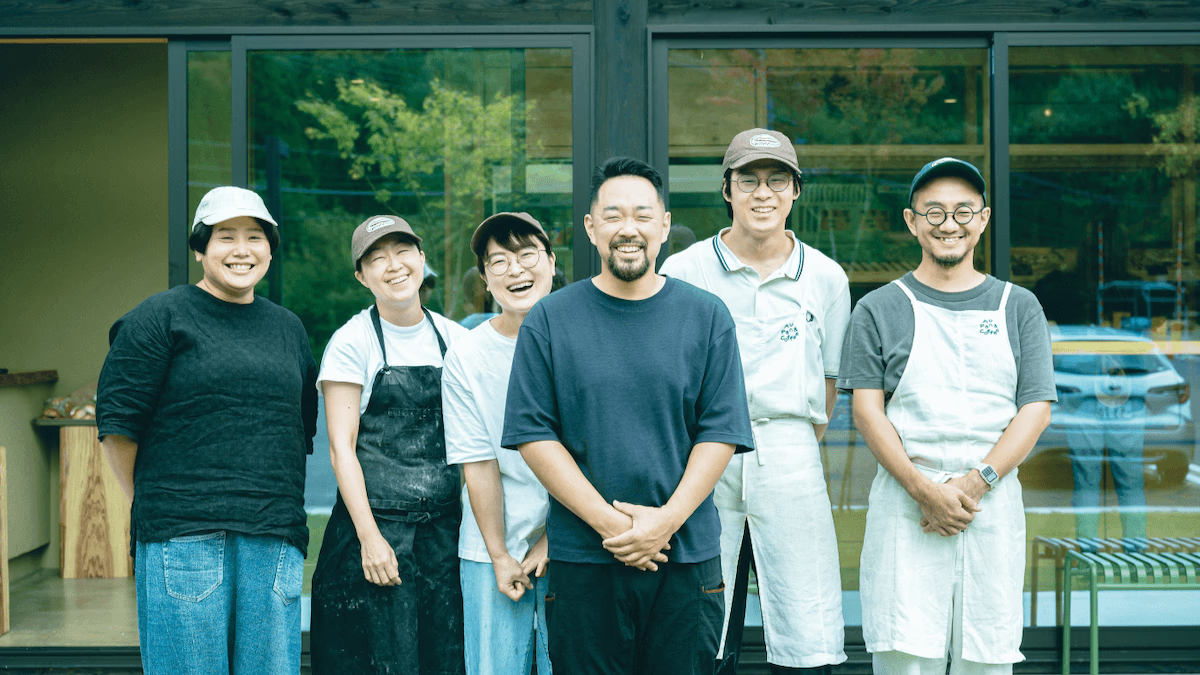「パンはあくまで手段。やりたいのは地域や社会とのつながりをどうつくるかということなんです」。
徳島・神山町のフードハブ・プロジェクトで、「かまパン」の製造責任者を務める笹川大輔さんは、いつもながらもどかしそうに言葉を探していました。パンをつくるときは、あんなに滑らかに手が動くのに、言葉はいつも指の間からこぼれ落ちちゃうんだよ、とでもいうように。
2024年9月30日、モノサスと徳島・神山町のフードハブ・プロジェクトが立ち上げに関わった「Au Pan & Coffee」が熊本・黒川温泉でオープンしました。笹川さんは、今も現地チームに伴走しています。神山で「地域のパン」をつくってきた経験は、「Au Pan & Coffee」のチームづくりにどう生かされたのでしょうか。笹川さんへのインタビューを軸にお伝えしたいと思います。
「熊本の温泉街で、パン屋から地域の課題解決やコミュニティづくりを。地域の関係性からつくるパン屋をプロデュース」
黒川温泉郷からフードハブにオファーが来た理由
博多駅から高速バスで約1時間半、熊本空港から車で約1時間。黒川温泉は、阿蘇地方の山あいに位置する熊本有数の観光地です。「黒川温泉一旅館」という考え方のもと、30軒の旅館と里山の風景をひとつの旅館に見立て、各旅館を「離れ部屋」、旅館をつなぐ小径は「渡り廊下」捉えて地域全体で黒川温泉を盛り上げてきました。
しかし、高度成長期やバブル期に流行した大規模ツアーの時代を終えて、温泉旅行はより個人的なものに変化しました。また、山あいのまちは過疎・高齢化が進み人手不足も深刻です。とりわけ和食の料理人は全国的にも減少しており、旅館ごとに料理人を確保するのは難しくなっています。また多様な経験を求めるインバウンド客のニーズに対して、一泊二食を提供する従来の温泉宿のスタイルのズレも生じていました。
このような課題に対して、旅館「奥の湯」を営む音成貴道さんが考えたのは「泊食分離」。黒川温泉に宿泊するお客さんが、食事できる場所があれば旅館ごとに板場をもたなくていいのでは?ーー音成さんはポストコロナに対応する事業者を支援する、経済産業省の「事業再構築補助金」を得て、8棟のレストランを中心とする地域の食のハブ「Au Kurokawa」をつくったのです。
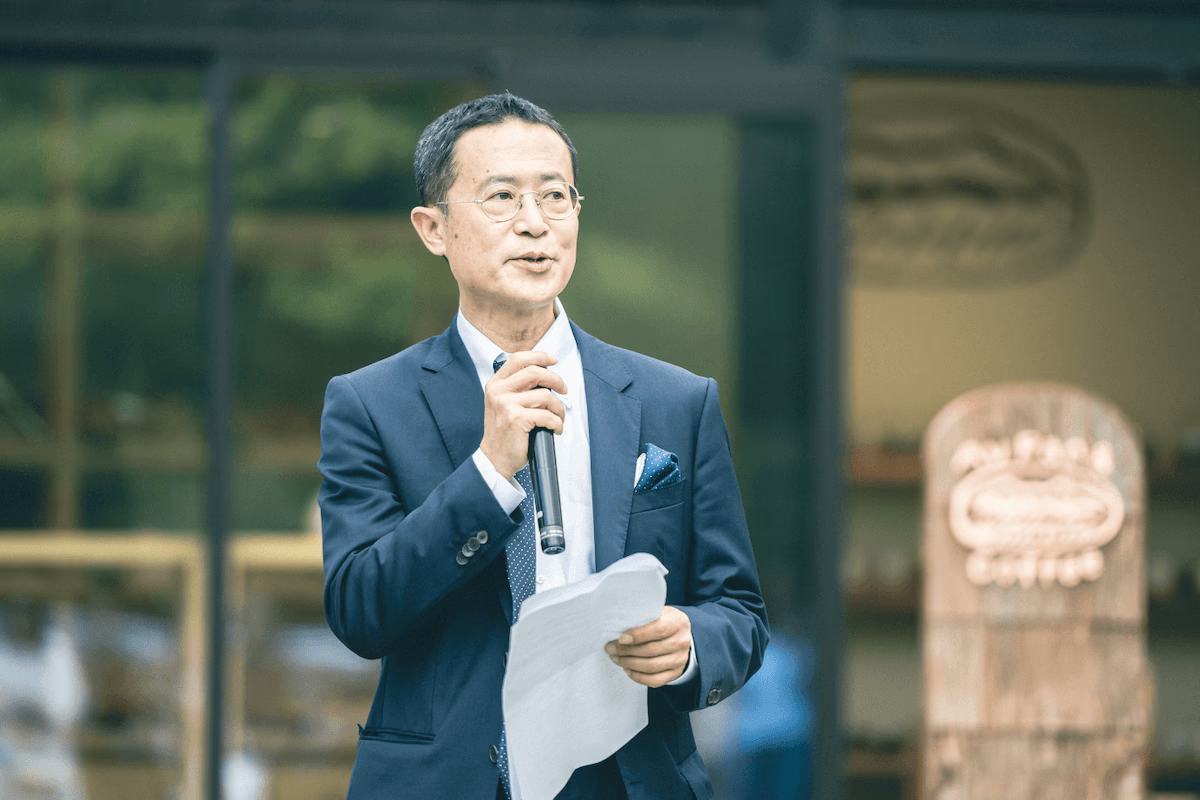
黒川温泉観光旅館協同組合代表理事であり、旅館「奥の湯」オーナーの音成貴道さん。Au Pan & Coffeeオープン時のレセプションにて 撮影:マエダトモツグ.
建物はできた。さあ、どんなお店をつくっていけばいいだろう? 「Au Kurokawa」にふさわしいお店を検討するなかで、浮かんだのが「パン屋をつくる」というアイデア。
パートナーになってくれるパン屋さんを探しているときに、つながったのがフードハブ・プロジェクト(以下、フードハブ)でした。神山は黒川温泉と同じく、中山間地域にあり過疎・高齢化という共通の課題をもつ町。「地方創生の成功例」として、音成さんも視察に訪れたことがあったそうです。
音成さんたちからのオファーを受けて、モノサスとフードハブは「笹川さんがやりたいかどうか」をまずは確認することにしました。「黒川温泉でパン屋をつくるプロジェクトをやらないか」と言われて、笹川さんはどう思ったのでしょうか。
「しろうと」を集めて、地域に根ざしたお店をつくる
「ありかなしかで言えば、ありかなって。こっちの主体となれる部分が大きかったからできるかなと思いました」。
話をもちかけられたときの気持ちを振り返る笹川さん。そのとき、思い浮かんでいたのはフードハブ立ち上げ当時に『ほぼ日刊イトイ新聞』で読んだ、料理家・土井善晴さんと糸井重里さんの対談記事「家庭料理のおおきな世界」でした。
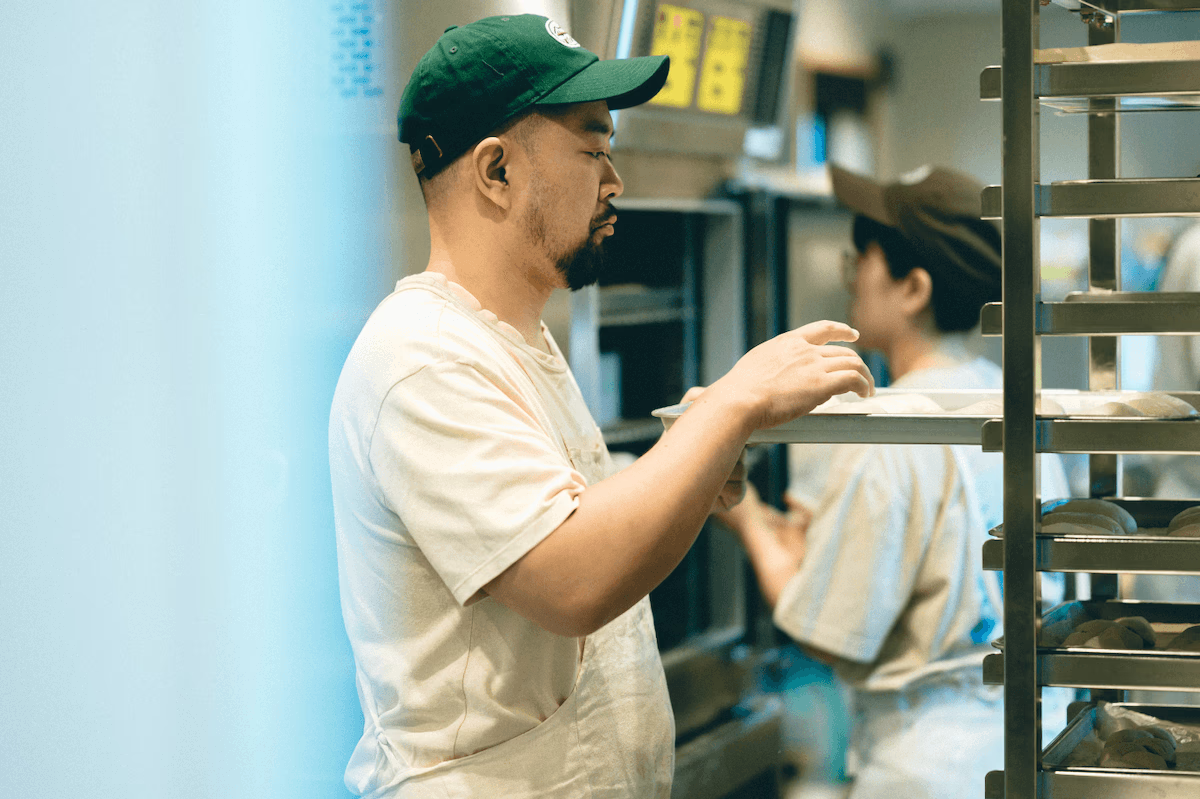
かまパン製造責任者・笹川大輔さん。Au Pan & Coffeeにて 撮影:マエダトモツグ.
「土井さんは『とにかく、しろうとを集めて、新しいお店をつくっている』って言っていて。それはなぜかというと、下手に技術があると自分がしたいことしかしないけど、しろうとは真面目だから料理以外のこともきちっとするし、誰の料理でもなく『この店の料理はどうあるべきか』を考えるからいいんだって」。
とりわけ心に残ったのは「その土地、その土地にふさわしいことをするのが、実はいちばん美しくて、おいしいですから」という土井さんの言葉。笹川さんは、パンづくりの経験のない「しろうと」を採用することにしました。
「職人をひとり採用するなら、アルバイトを3人入れたかったんです。前職でも社員ひとりとアルバイトだけでやりくりしていましたが、意外とうまくいっていた。ひとりの機能よりも3人のアイデアがあるほうがいいし、下手に技術のある人が自分の好きにやろうとするより、圧倒的にチームとして強いという体感があったので。それを言語化してくれたのが土井さんでした。かまパンでそれを体現してきたので、他の場所でもできるよねというロジックが成立しました」。
Au Pan & Coffeeに採用されたメンバーは、一年間パン屋でアルバイトした人以外は、パンづくりは初心者ばかり。いわゆるパン職人はゼロの状態からスタートしました。メンバーたちは、かまパンで約1ヶ月トレーニングを受けてから、黒川温泉に移って"パン屋づくり"にとりかかりました。
神山でのトレーニングではアイデンティティを注入した
いつもの食パン、超やわ食パン、レーズンパン、ベーコン・エピ、野菜のローフ、ドーナッツ......。Au Pan & Coffeeには、かまパンと同じパンがたくさん並んでいます。しかし、食べてみるとかまパンとは違う味わいがあります。もちろん、つかっている牛乳が違っていたり、エピのベーコンが違うなど、素材の違いもあるのだけれど、それだけでは説明できない気がしました。では、パンの味をつくっているのはいったいなんなのでしょうか?
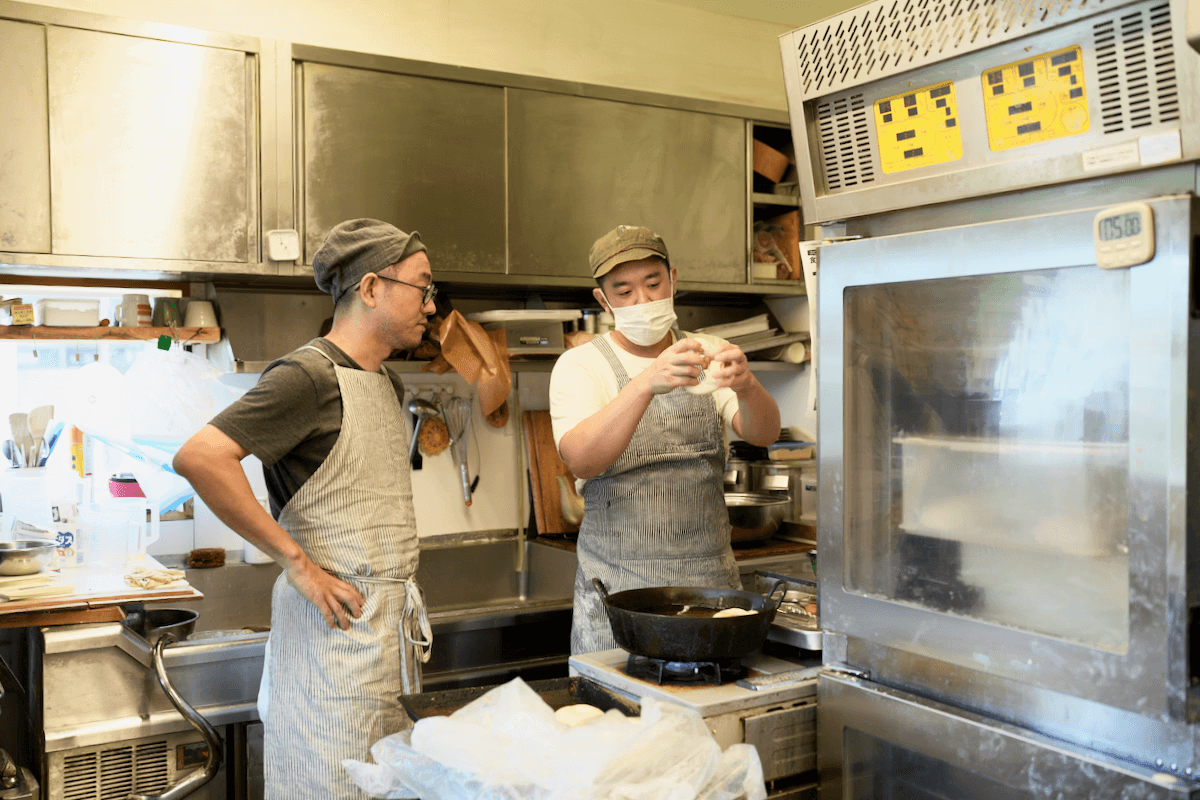
Au Pan & Coffeeのストア・マネージャー菊池昭一さんにドーナツの揚げ方を教える笹川さん
「完全に、人のアイデンティティというか、思考だと思います。間違いないと思いますね。その人がなぜパンをつくっているのか、本質的な部分を握っておかないと味はおいしくてもなんか違うんですよね。Au Pan & Coffeeのパンはおいしく、きれいにできているけれど、中身の部分はまだこれからだと思います。だからこそ、神山に来てもらってかまパンで1ヶ月間トレーニングをしたときは、徹底的にアイデンティティを注入しました」。
トレーニングでは、パンづくりの技術を教えると同時に、メンバーそれぞれが自分の考えを伝え合うミーティングにも時間を割きました。「極端な言い方をすると、技術は二の次なんです」と笹川さんは言います。
「パンを焼く技術の基本を学んだら、かまパンレシピのパンを焼くことはできるけれど、それだとレシピ提供になっちゃう。どうやって地域とつながっていくか。どうやって社会とつながっていくかというときに、パンはあくまでその手段なんです。だから、トレーニングでは『なぜ、これをやるのか』について、ずっと話し合いながらやってきました。フードハブがやろうとしてきたことを伝えることが一番大事だったので。今回は、フードハブから(澤入)三芳が現地のメンバーに入ったので、彼女がいる限りそこまでズレないというのも重要なポイントでした」。
一番伝えたかったのは「自分たちのものごとは自分たちで考えて、自分たちで決める」ということ。誰かが言っていたから、オーナーが言ったからではなく、自分たちで考えて「これがいい」と思うことをやっていくチームをつくりたかったそうです。
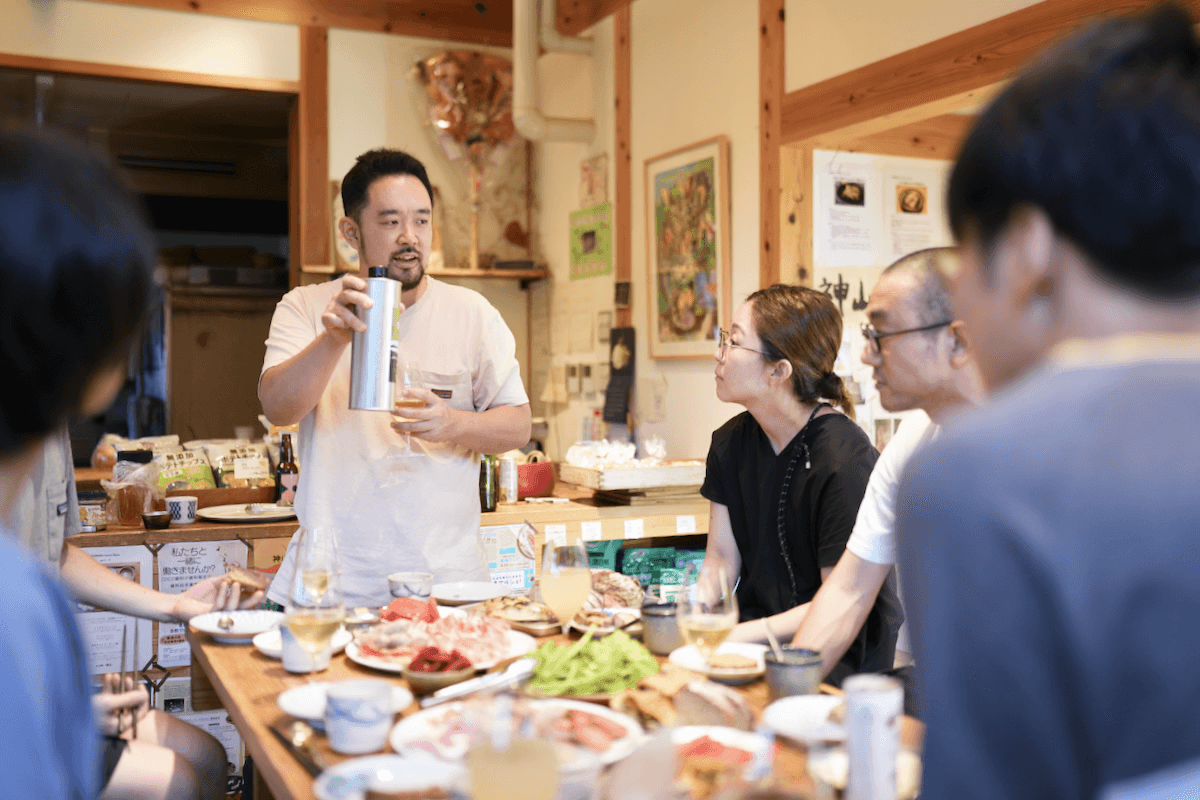
かまパンではスタッフがお互いの考えていることを聞く時間をとても大切にしています
「仕事では、どうしてもイエスかノーか、白黒をつけようとしてしまうけれど。そうではなくて自分の意見を言う。もし、デメリットがあることがわかっているなら、『じゃあ、今はこっちをやっておこう』と決めつつ、もやもやをちゃんと滞在させるってことは伝えたかったですね。パンはその繰り返しなので。パンづくりを通じて、わからないっていう状態も大事だし、それをなくしちゃうと自分がなくなってしまうんだよってことを伝えられたらいいなと思っていました」。
発酵がうまくいかなかったり、同じようにやっているつもりでもパンの調子が違っていたり。パンをつくる日々には「わからない」がたくさん現れます。そのたびに立ち止まってミーティングを開き、それぞれが自分で考えて意見を言い合うこと。笹川さんがパンづくりの技術より前に伝えたかったのは、そのプロセスの大切さだったのです。
メンバー全員で同じ景色を見ること
かまパンでのトレーニングの後は、黒川温泉周辺の生産者さんを訪ねました。「地域と関係をつくり、そのつながりのなかでパンをつくる」ことを体感してもらうためです。
「チーム全員でリサーチに行くのは、フードハブの特徴だと思っていて。みんなで一緒に同じ景色を見るのは大事だなと思うんです。そのとき、僕が農家さんや生産者さんと話しているのをどこまで聞いているかは気にしていました。ただ一緒に見に行くだけではつながれないし、見学して終わりになってしまいますから。ちゃんと生産者さんとつながるには、社会の生態系のなかに自分たちと生産者さんたちを位置付けて、理解したうえで会話できないと通じ合えない。今回は、生産者さんたちとちゃんと繋がれた実感がありました」。

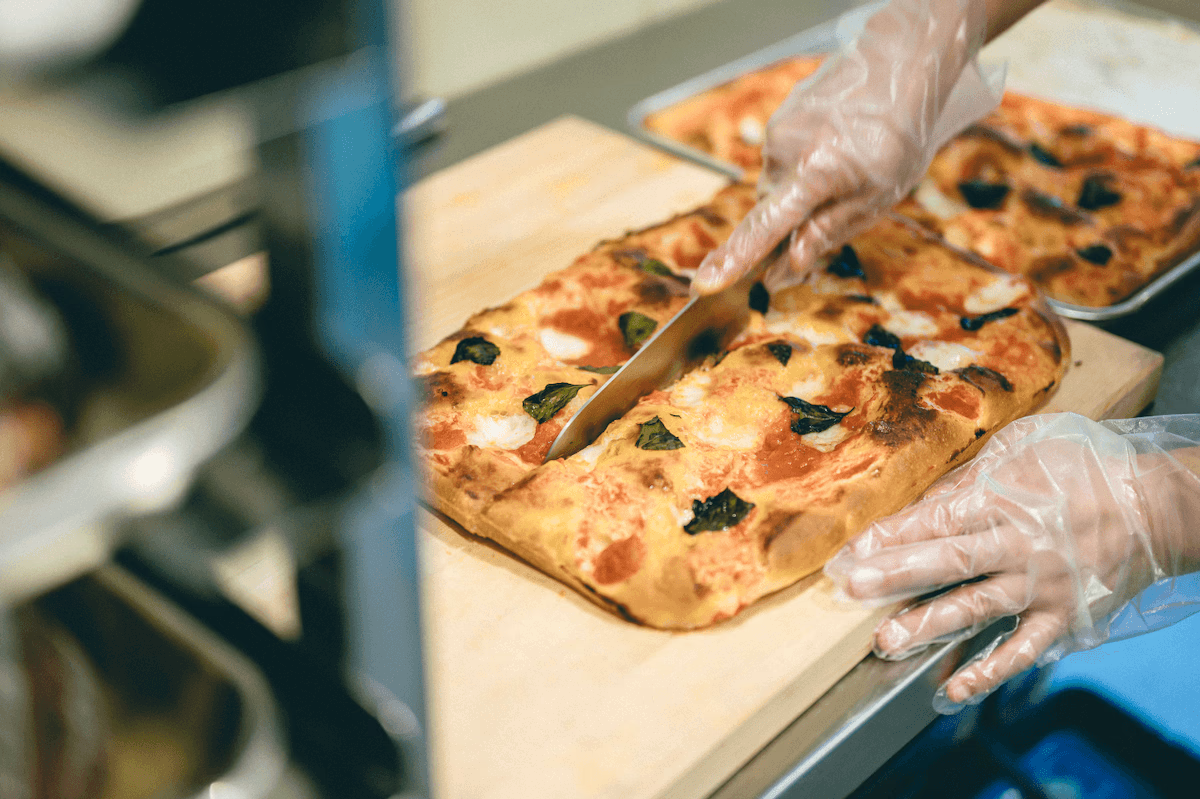
Au Pan & Coffeeで使う食材は、黒川温泉郷から半径50km圏内のものを使う。地元の生産者さんとのつながりを大切にしながらパンを焼く 撮影:マエダトモツグ.
訪問したなかには、地元で名前は知られてはいても、「誰がどんなものをつくっているのか」までは知られていなかった生産者さんたちもあったそうです。Au Pan & Coffeeによるリサーチは、細くとも地域の関係性を編む糸になったのかもしれません。だけど、笹川さんは「地域の何かを見て知った気になるのは違うと思う」とも言います。では、地域に根ざしたパン屋、あるいは「地域のパン」とはどういうパンなのでしょうか。
「地域との関係性のあるパンというも、今はちょっと違う気がしていて。前は『顔が見える関係性のなかでつくる』『知っている人に食べてもらう』とかあったんですけど。なんか今は違うんだよなあ。存在というか。今となっては、食べてもらうに越したことはないけれど、『あそこにかまパンがあって、働いている人がPTA会長やっているよね』って認識されるだけで自分はうれしい。その自分がここでパンを焼き続けることが地域のパンなのかな、って思っています」。
笹川さんはやっぱりもどかしそうに、「言葉は誤解を生むから難しいよね」と言いました。たぶん、実感として自分のなかに確かにあって、かまパンでやっていることがそのまま「地域のパン」になっているのだろうし、だからこそ「同じ景色を見る」ことを通して、Au Pan & Coffeeのメンバーに伝えようとしたのではないかと思うのです。
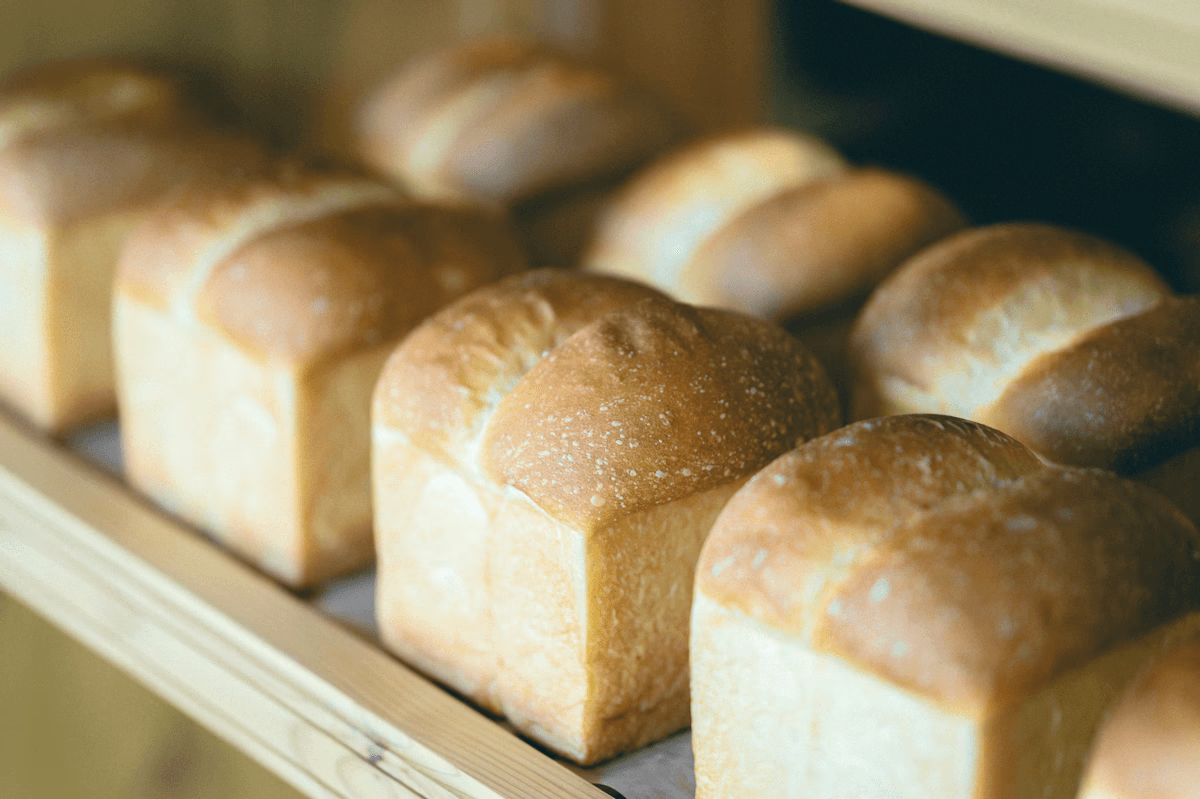
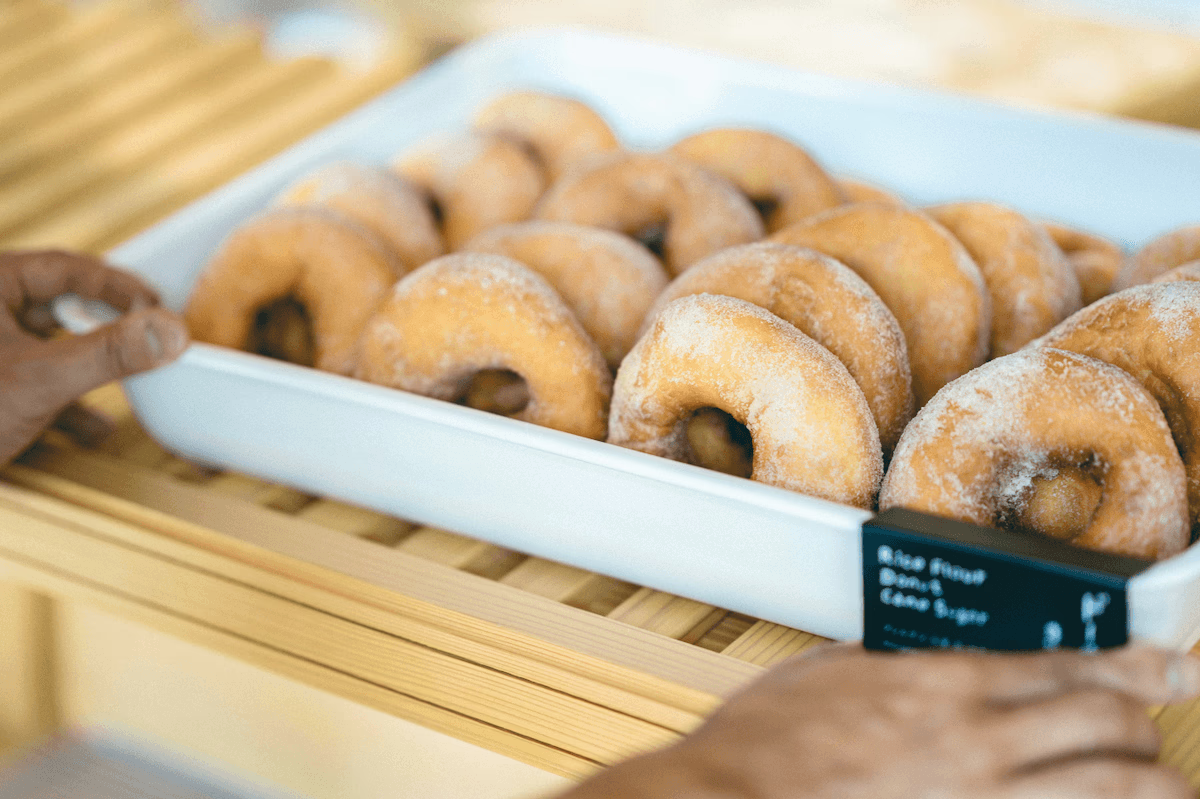

撮影:マエダトモツグ.
関係性を上手に"発酵"させていく
笹川さんのなかにある実感の輪郭を言葉で確かめたくて、パンになぞらえてみることにしました。たとえば、かまパンというお店もパンのように発酵していると考えてみたらどうだろうーーかまパンチームという天然酵母に、地域の生産者さんたち、地元の人たちとの関係性が加わって発酵が進んでいるとしたら? 私のたとえを聞いて、笹川さんはうれしそうに笑って「めっちゃおもろい!今日はいい話が聞けたなぁ」とうれしそうに言いました。あれ、インタビューして話を聞いているのはわたしのはずだったんだけどな......。
「うんうん、かまパンは関係性の発酵があって今がある。黒川温泉でも、デザイナーさんや店舗の設計、エクステリアデザインなど、いろんな人が関わってくれたので、これから発酵していけばいいなと思います。発酵ってタイミングを間違えるとうまくいかなくなるので。ときには自分が入ったほうがいいときもあるかもしれないけど、Au Pan & Coffeeというお店に自分という菌がどう作用するのかはけっこう大事だなと思っていて。ずっと現場にいないからこそどのタイミングで関わるのか、その距離感を測るのは難しいです」。
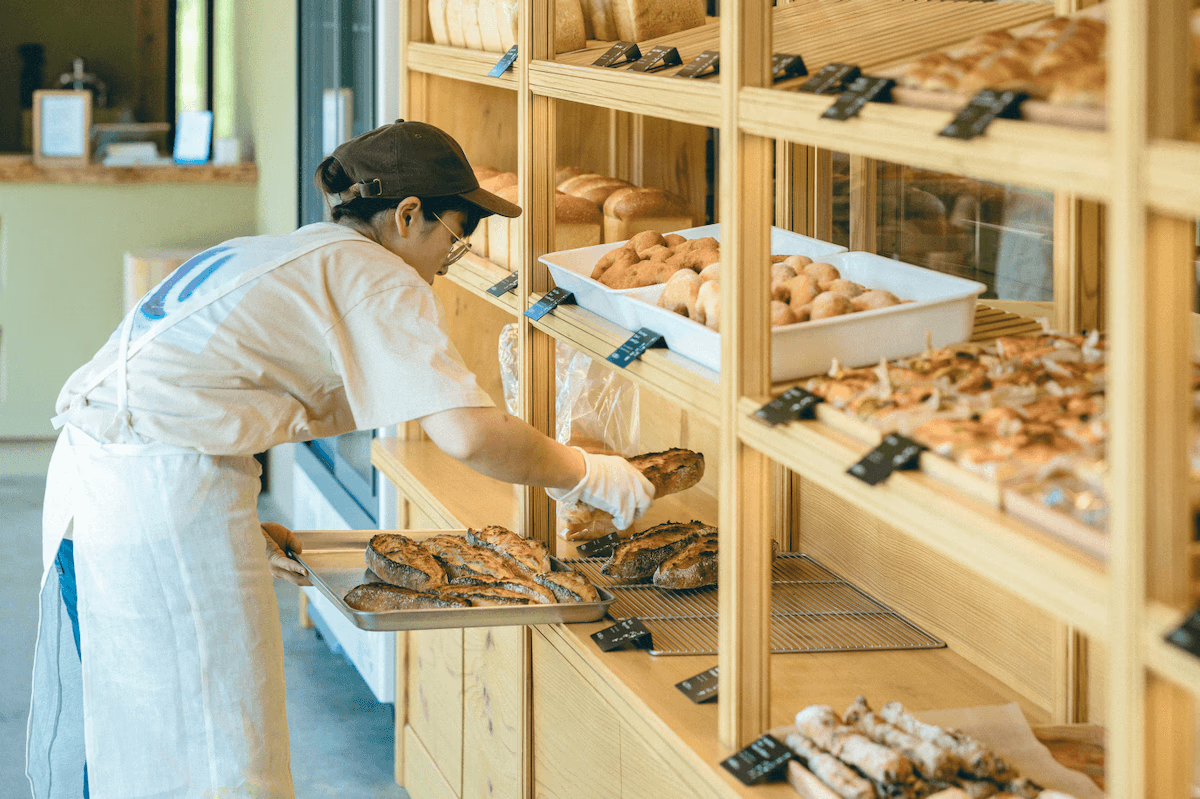
フードハブから出向してAu Pan & Coffeeのオープンに関わる澤入三芳さん 撮影:マエダトモツグ.
常々、笹川さんは「自分のことをパン職人と呼んでほしくない」と言うのですが、お話を聞いていてその意味が少しわかった気がしました。もちろん、技術的にも経験の豊富さにおいても、パンに対する情熱もセンスも、パン職人と呼ぶにふさわしい人であることは間違いありません。ただ、笹川さんがつくりたいのはパンを通してつくられていく「何か」の方だからなのだと思います。
「パンってもっと誰でも触れていいものだと思っているから、誰にも触れられない、自分だけのものにしたくなかったんです。自分のお店をつくって『これが笹パンです』っていうのは違うなって。最近、ずっと『おいしい』について考えていて、普通であることは大事だなと思う。自分は、食べた結果として『おいしかったね』ってふうにしたいんです。そこには解説とかいらなくて、僕らの苦労とか見えなくてよくて。ちゃんと考えてつくられたものはおいしいし、かまパンのパンは特にそれが強いなと思っています」。
かまパンはオープンからもうすぐ9年。Au Pan & Coffeeは今、酵母が生まれたばかりです。きっと黒川温泉の日常のなかで年月を重ねるうちに、その関係性は発酵して他にはない味わいを生み出していくに違いありません。またいつか、Au Pan & Coffeeでパンとコーヒーを食べたいです。みなさんも、ぜひ黒川温泉へ!とても気持ちのよい温泉に浸かって、黒川でしか食べられないパンとコーヒーを味わってみてください。
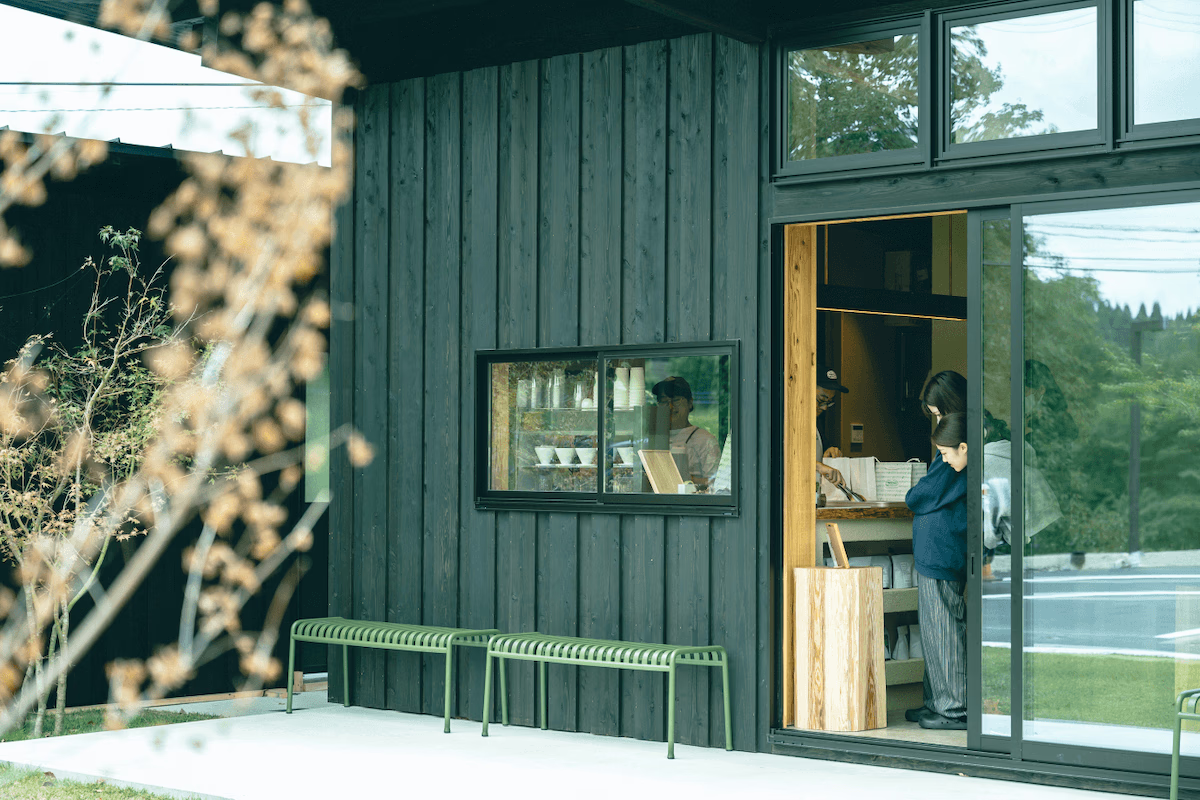
撮影:マエダトモツグ.
